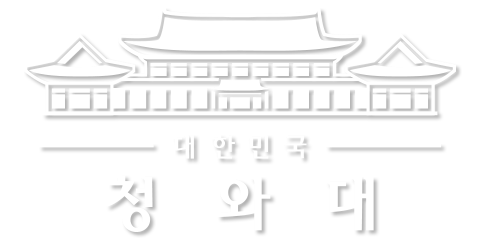이 웹사이트는 제19대 대통령 임기 종료에 따라 대통령기록관이 「대통령기록물 관리에 관한 법률」에 의해 이관받아 서비스하는 대통령기록물입니다. 자료의 열람만 가능하며 수정 · 추가 · 삭제는 불가능합니다.
다만, 「개인정보보호법」에 의하여 개인의 정보를 보호받기 원하시는 분은 관련 내용(요청자, 요청내용, 연락처, 글위치)을 대통령 웹기록물 담당자(044-211-2253)에게 요청해 주시면 신속히 검토하여 조치해 드리겠습니다. 감사합니다.
SPEECHES & REMARKS
BRIEFINGS

Fellow Koreans,
The global semiconductor market is experiencing a period of seismic changes. The COVID-19 pandemic is accelerating the transition to a contact-free, digital economy. Such Fourth Industrial Revolution technologies as IoT and artificial intelligence are rapidly growing. In step with these changes, it is forecast that the semiconductor industry will likely enter a super cycle in which the demand for chips rises significantly and the boom lasts for a long time.
Countries around the world have embarked on reorganizing supply chains in ways that prioritize their own needs, engaging in fierce competition. The direction we should take is clear. Preemptive investments should further strengthen our domestic industry ecosystem, so it cannot be shaken by external shocks. Being at the forefront of global supply chains will allow us to seize this opportunity as our own.
This semiconductor manufacturing complex in Pyeongtaek is ushering in the future of the Republic of Korea’s semicnductor industry. Here today, I would like to reaffirm the vision of our semiconductor industry and present our K-semiconductor strategy to the people. The semiconductor industry, businesses in need of chips, central and local governments and even the institutes that foster technical professionals came together with one mind to draw upon their insights and devise this strategy.
I would like to thank everyone joining us today: semiconductor business leaders, university presidents and other experts in academia, lawmakers from the ruling Democratic Party’s special committee on semiconductor technology and heads of local governments. Despite the COVID-19 situation, many have participated in today’s event. I believe their presence here attests to how important our semiconductor industry’s future is. For its part, the Government will always stand by the industry and make sure that Korea’s pride at being a semiconductor powerhouse helps it prevail over the global competition.
Fellow Koreans,
To date, the global semiconductor market has been led by Korea, the United States and Taiwan. Korea has steadfastly ranked No.1 globally in terms of the memory semiconductor market share for the past 20 years. When it comes to system semiconductors, the United States stays ahead in design while Taiwan excels in manufacturing. Korea follows closely, staying within the top two of both fields.
Now major business rivals around the world are making massive investments to gain dominant market positions going forward. Korean companies have also continued to take on challenges and innovate – readying for periods of upheaval. This Pyeongtaek semiconductor manufacturing complex is just such a forward base.
Samsung Electronics Pyeongtaek Line 1 and Line 2, which opened in 2017 and last year, operate non-stop to supply the world with state-of-the-art memory chips. Production of system semiconductors will commence in earnest in the second half of this year. When Line 3 – at 25 times the size of a soccer field – is completed by the end of next year, the complex will be listed as the world’s largest semiconductor production line.
For its part, the Government also formulated the system semiconductor strategy and vision in 2019 and has worked with the industry to move toward the goal of emerging as a comprehensive semiconductor powerhouse in 2030. We are now seeing this public-private sector cooperation producing tangible results. Having achieved US$30 billion in exports last year, system semiconductors have become one of our country’s top five export items. Overall semiconductor exports have also been on the rise for 10 consecutive months, and annual exports are forecast to exceed US$100 billion this year.
Domestic businesses are now way ahead of their competitors. They will invest more than 510 trillion won over the next decade. Samsung Electronics is planning to expand memory and system semiconductor production lines in Pyeongtaek and Hwaseong on a large scale, and SK hynix also plans to build a new massive production base in Yongin. I have great respect for the courage of entrepreneurs who in the face of uncertainty have taken on new challenges more actively by choosing to make pioneering investments.
Fellow Koreans,
Rivalries among semiconductor businesses have now begun to draw in countries. Countries around the world are providing such exceptional support as subsidies and tax incentives as part of the efforts to reorganize global semiconductor supply chains in ways that meet their own needs.
My Administration will also work with businesses as one team so Korea stays a semiconductor powerhouse. We will definitely support their efforts. Centered around Pyeongtaek, Hwaseong, Yongin and Cheonan in Gyeonggi and Chungcheong provinces, a “K-semiconductor Belt” will be established so Korea can emerge as the world’s foremost semiconductor country. In addition to semiconductor production processes ranging from design and manufacturing to packaging, we will establish a close-knit supply network for materials, parts and equipment. In Pangyo, where IT companies are clustered, we will create a Fabless Valley to enhance competitiveness in design. In the Chungcheong region, including Cheongju, a complex dedicated to packaging will be built to further increase our chips’ commercial value. Yongin, home to SK hynix’s new production complex, will be fostered as a specialized material, parts and equipment complex that is technologically self-sufficient, and we will make Hwaseong and Cheonan advanced semiconductor equipment clusters through cooperation with leading global companies.
Besides creating the complex, all-embracing support will be provided, including through tax credits, financing, regulatory reform and the expansion of infrastructure, so that corporate investments can be made in a timely manner and production capacity can be expanded rapidly. By designating semiconductor production a key national strategic technology, we will increase tax incentives for related facility investment by up to six-fold. It will become possible to deduct up to 50 percent of R&D investment from taxes.
We will provide low-interest loans for facility investments by operating a special financial support program backed by more than 1 trillion won. The time required for various licensing and approval will be shortened as much as possible, and electricity transmission lines, water and wastewater recycling facilities will be expanded so that semiconductor manufacturing plants can be built swiftly.
All government resources will be mobilized to lay the foundation for sustainable growth. Over the next 10 years, we will nurture 36,000 talented key semiconductor specialists and strive to develop core technologies with high growth potential, such as next-generation power semiconductors, artificial intelligence semiconductors and state-of-the-art sensors. Discussions with the National Assembly on enacting a special act on semiconductors will also commence in earnest to create regulatory exemptions, train talented individuals and expand support for rapid investment.
In just a moment, a ceremony for signing MOUs on solidarity and cooperation to strengthen the semiconductor ecosystem will be held. Based on a cooperation agreement between companies that produce and use automotive semiconductors as well as a public-private sector investment agreement, the Government, industry, academia and research institutes will work together to stabilize the supply of semiconductors for vehicles and foster highly qualified semiconductor professionals. We will sign an investment agreement on an advanced equipment manufacturing cluster with the world’s leading semiconductor equipment manufacturer ASML to make up for shortcomings in the domestic supply chain.
Fellow Koreans,
Preemptive investments by businesses and the mutually beneficial efforts of industry, academia and research institutes are already demonstrating their strength. Through Korea’s public-private semiconductor strategy, we will surmount the rough waves caused by global supply chain reorganization.
We will solidify our position as the world’s top memory semiconductor producer and take the lead globally in system semiconductors as well, thereby achieving the goal of becoming a comprehensive semiconductor powerhouse in 2030. Building upon the competitiveness of our semiconductor industry, we will secure advantageous positions ahead of others through competition in various industries and take off as a pacesetting country in the post-COVID-19 era.
I join the people in encouraging support for the Republic of Korea’s semiconductor industry, which will write yet another success story.
Thank you.



